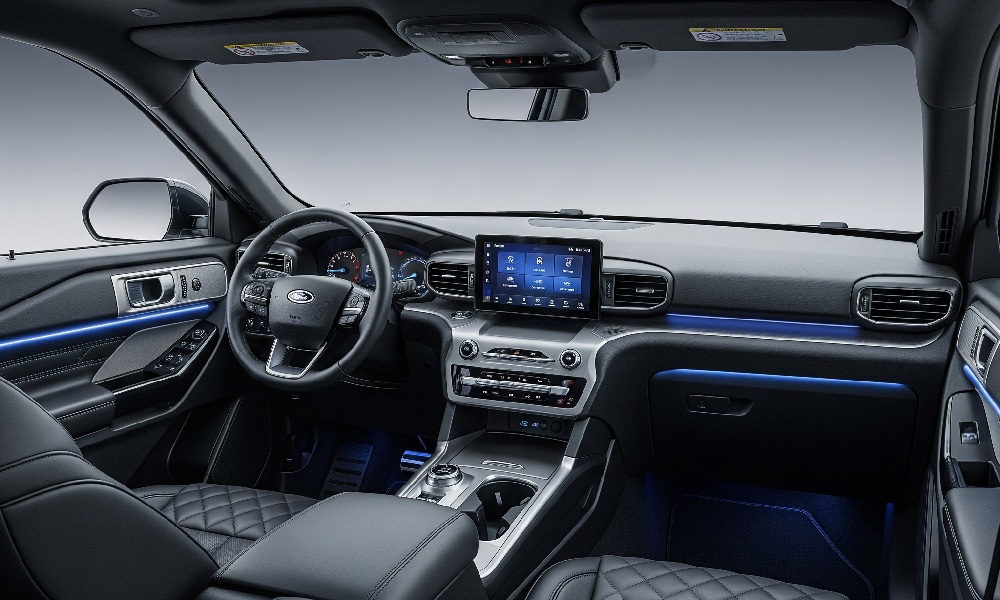Ford Electric Batteries vs Fuel Efficiency: How To Measure
The Shift from Combustion to Electric The automotive industry has witnessed a seismic shift towards electrification in recent years. Ford, one of America’s oldest and most iconic car manufacturers, has been at the forefront of this revolution. The transition from internal combustion engines to electric batteries marks a pivotal moment in the history of Ford, … Continued
The Shift from Combustion to Electric
The automotive industry has witnessed a seismic shift towards electrification in recent years. Ford, one of America’s oldest and most iconic car manufacturers, has been at the forefront of this revolution. The transition from internal combustion engines to electric batteries marks a pivotal moment in the history of Ford, comparable to the company’s introduction of the assembly line over a century ago.
The journey into the electric vehicle (EV) market began with the introduction of hybrid models in the early 2000s. However, it wasn’t until the launch of the all-electric Mustang Mach-E in 2020 that Ford truly accelerated its electric ambitions. This bold move signalled the company’s commitment to a future where fuel efficiency is measured not in liters per 100 kilometers but in kilowatt-hours per kilometer.
The rapid development of Ford EVs has been nothing short of remarkable. From concept to production, Ford has demonstrated its ability to adapt quickly to changing market demands and environmental concerns. The company’s investment in electric technology has been substantial, with billions of Canadian dollars poured into research, development, and retooling of manufacturing facilities.

Electric Vehicle Efficiency: Wh/km vs L/100km
To fully appreciate the impact of electric batteries on fuel efficiency, it’s crucial to understand how efficiency is measured in electric vehicles compared to their gasoline-powered counterparts. Traditional vehicles measure fuel efficiency in liters per 100 kilometers (L/100km), with lower numbers indicating better efficiency. For instance, a compact car might consume 6 L/100km on the highway.
Electric vehicles, however, use a different metric: watt-hours per kilometer (Wh/km). This measure represents the amount of electrical energy consumed to travel one kilometer. A typical electric vehicle might use around 150-200 Wh/km. To put this in perspective, let’s consider the Ford Mustang Mach-E, which has an efficiency rating of approximately 184 Wh/km in its standard range, rear-wheel-drive configuration.
Converting between these two metrics isn’t straightforward due to the different energy densities of gasoline and electricity. However, to provide a rough comparison, we can use the concept of MPGe (Miles Per Gallon equivalent) and convert it to kilometers. The Mustang Mach-E’s 184 Wh/km translates to approximately 2.1 Le/100km (Liters equivalent per 100 kilometers), showcasing the impressive efficiency of Ford electric vehicles.
Ford Electric Battery Technology
At the heart of the Ford electric revolution lies its battery technology. The company has made significant strides in developing high-capacity, long-lasting batteries that power its new generation of EVs. The Mustang Mach-E, for instance, comes with two battery options: a standard-range 75.7 kWh pack and an extended-range 98.8 kWh pack.
These lithium-ion battery packs are composed of hundreds of individual cells, carefully designed and arranged to maximize energy density while minimizing weight. The Ford battery management system (BMS) is crucial in maintaining optimal performance and longevity. It monitors and controls the temperature, voltage, and current of each cell, ensuring balanced charging and discharging.
One of the key innovations in Ford electric batteries is using pouch cells instead of cylindrical cells. Pouch cells allow more efficient packaging, resulting in higher energy density and better thermal management. This technology enables Ford to offer impressive ranges in its electric vehicles, with the Mustang Mach-E capable of travelling up to 490 kilometers on a single charge in its extended-range configuration.
Fuel Costs: Electric (CAD/kWh) vs. Gasoline-Powered (CAD/L) Ford Vehicles
One of the most compelling arguments for electric vehicles is the potential for significant fuel cost savings. To illustrate this, let’s compare the fuel costs of a Ford electric vehicle like the Mustang Mach-E with a comparable gasoline-powered Ford SUV, such as the Ford Edge.
As of 2023, the average electricity rate in Canada is approximately 0.174 CAD/kWh. For the Mustang Mach-E, with its efficiency of 184 Wh/km, the cost to travel 100 km would be:
(184 Wh/km * 100 km) / 1000 * 0.174 CAD/kWh = 3.20 CAD
Now, let’s consider the Ford Edge, which has a combined fuel efficiency of about 10 L/100km. With an average gasoline price of 1.50 CAD/L (as of 2023), the cost to travel 100 km would be:
10 L/100km * 1.50 CAD/L = 15.00 CAD
This comparison reveals that the electric batteries in the Mustang Mach-E offer a fuel cost that is less than a quarter of its gasoline counterpart. Over the vehicle’s lifetime, this difference can amount to thousands of Canadian dollars in savings.
Range and Performance: How Ford EVs Stack Up in Kilometers
Range anxiety has long been a concern for potential EV buyers, but Ford has made significant strides in addressing this issue. The Mustang Mach-E, depending on the configuration, offers a range between 340 to 490 kilometers on a single charge. This range puts it in direct competition with other long-range EVs and makes it suitable for daily commutes and longer journeys.
But range is just one aspect of performance. Ford EVs have also proven to match or exceed their gasoline counterparts regarding acceleration and top speed. For instance, the Mustang Mach-E GT Performance Edition can accelerate from 0 to 100 km/h in just 3.7 seconds, rivalling many sports cars.
It’s worth noting that electric vehicles often perform better in city driving than on highways, unlike traditional vehicles, due to the regenerative braking system, which recaptures energy during deceleration and stop-and-go traffic, contributing to improved fuel efficiency in urban environments.
CO2 Reduction in Grams per Kilometer with Ford Electric Fleet
The environmental benefits of electric vehicles are a crucial factor in their growing popularity. By shifting from internal combustion engines to electric batteries, Ford is significantly reducing the carbon footprint of its vehicle fleet. To quantify this, let’s compare the CO2 emissions of the Mustang Mach-E with a gasoline-powered Ford Edge.
The CO2 emissions of an electric vehicle depend on the energy mix of the electricity grid. In Canada, where a significant portion of electricity comes from renewable sources, the average emissions are approximately 140 g CO2/kWh. For the Mustang Mach-E, this translates to:
184 Wh/km * 140 g CO2/kWh / 1000 = 25.76 g CO2/km
In contrast, the Ford Edge, with its fuel efficiency of 10 L/100km, produces about 230 g CO2/km when burning gasoline.
This comparison shows that the Mustang Mach-E produces less than 12% of the CO2 emissions of its gasoline counterpart. As Canada continues to decarbonize its electricity grid, the environmental benefits of Ford electric vehicles will only increase.
The Future of Ford: Kilowatts and Liters in Hybrid Technologies
While Ford is making significant strides in all-electric vehicles, the company recognizes that transitioning to a fully electric fleet will take time. As such, Ford is also investing heavily in hybrid technologies, which combine the benefits of electric batteries with the range and familiarity of gasoline engines.
The Ford hybrid lineup includes popular models like the Fusion Hybrid and the Escape Hybrid. These vehicles use smaller battery packs (typically around 1.4 kWh) with efficient gasoline engines. The result is a vehicle that can operate on electric power for short distances and at low speeds, significantly improving overall fuel efficiency.
For example, the Ford Escape Hybrid achieves a remarkable fuel efficiency of 5.4 L/100km in combined city/highway driving. This fuel efficiency represents a 40% improvement over its non-hybrid counterpart. The hybrid system allows for regenerative braking and electric-only operation in certain conditions, maximizing efficiency without compromising on range or performance.
Looking ahead, Ford plans to expand its hybrid offerings while simultaneously pushing forward with all-electric models. This balanced approach allows the company to cater to a wide range of consumer needs while steadily reducing its overall carbon footprint.
Consumer Perspective: Cost-Benefit Analysis of Ford Electric Options in CAD per 100 Kilometers
For many consumers, the decision to switch to an electric vehicle comes down to a careful cost-benefit analysis. While electric batteries offer significant savings in fuel costs and maintenance, the higher upfront cost of EVs can be a deterrent. Let’s break down the costs of owning a Ford Mustang Mach-E compared to a gasoline-powered Ford Edge over five years, assuming an annual driving distance of 20,000 km.
Mustang Mach-E (Standard Range RWD):
- Purchase price: 64,995 CAD
- Fuel cost per 100 km: 3.20 CAD
- Annual fuel cost: 640 CAD
- 5-year fuel cost: 3,200 CAD
- Estimated maintenance cost over 5 years: 1,500 CAD
- Total 5-year cost: 69,695 CAD
Ford Edge SEL AWD:
- Purchase price: 43,999 CAD
- Fuel cost per 100 km: 15.00 CAD
- Annual fuel cost: 3,000 CAD
- 5-year fuel cost: 15,000 CAD
- Estimated maintenance cost over 5 years: 4,000 CAD
- Total 5-year cost: 62,999 CAD
While the initial cost of the Mustang Mach-E is higher, the savings in fuel and maintenance costs narrow the gap significantly over time. Additionally, many provinces in Canada offer incentives for EV purchases, which can further reduce the upfront cost.
It’s also worth considering the intangible benefits of owning an electric vehicle, such as reducing one’s carbon footprint, the convenience of home charging, and the often superior performance characteristics of EVs.
The Electric Future of Ford
The transition from liters to kilowatt-hours represents more than just a change in how we measure energy consumption; it signifies a fundamental shift in how we think about personal transportation. As battery technology continues to improve and charging infrastructure expands, the benefits of electric vehicles will only become more pronounced.
The Ford commitment to electrification, evident in models like the Mustang Mach-E and upcoming electric F-150, demonstrates the company’s vision for the future. By balancing the development of all-electric vehicles with hybrid technologies, Ford is ensuring a smooth transition for consumers while steadily improving its fleet’s overall efficiency and environmental impact.
As consumers, the choice between electric and gasoline-powered vehicles is becoming increasingly apparent. While the higher upfront costs of EVs remain a consideration, the long-term savings in fuel and maintenance costs, combined with the environmental benefits, make a compelling case for going electric.
In the coming years, we can expect to see further innovations in battery technology, charging solutions, and vehicle design from Ford. As the company continues to invest in electric mobility, it’s not just transforming its product line – it’s helping reshape the entire automotive industry.



